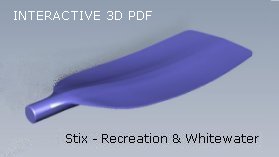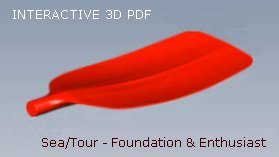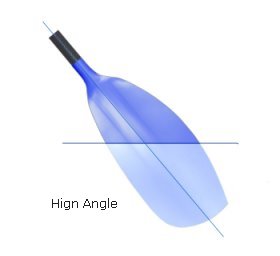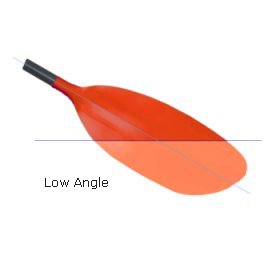Blade Features
Streamlyte paddle designs incorporate a number of key features which result in their high performance and smooth feel in the paddlers hands. Before looking at some of these advanced features in detail you can take an all round tour of our basic blade shapes with our interactive 3D .pdf files which have been generated straight from the CAD models used in the production of our moulds. You can view these in Adobe Acrobat Reader from version 8.0 upwards. Simply right click on the images below and choose 'open in new tab or window'. When they open in the reader just click and drag on the models to manipulate them.


Dihedrals, Spines and Spoons
Most of our blades feature a dihedral down the centre axis of the blade face and a spine down the centre axis of the back. The prominence of these two, combined with the amount of spoon in each blade all affect the performance in different ways.
The purpose of the dihedral is to encouage water to spread to either side of the centre line and flow outwards to the edges of the blade before spilling off. A blade with no dihedral, once tipped at an angle will allow a greater volume of water to flow in one direction across the whole blade surface and spill off. To compensate for this the paddler will grip the paddle shaft harder to try and twist the blade back which usually results in a reversal of the effect and the direction of flow across the blade. This constant change is felt as 'flutter' in the blade which is inefficient and tiring to the paddler.
The spine in the blade will serve to provide strength to a blade and also acts to some degree like a dihedral in backward strokes. However a spine that is too prominent can create cavitation in the water flow during slicing strokes making the blade unstable so we choose a compromise design between strength and dihedral effect according to the purpose of the blade.
The amount of spoon in a blade affects how much water is retained on the blade face before it spills away. More spoon across a blade works best for touring shapes while less is required for whitewater. More spoon down the length of the blade affects the 'catch' of the blade.
Our nylon Stix range of blades feature a fairly strong dihedral spreading to a smooth shape that controls the flow of water off the blade. the back of the blade has a low spine and the amount of spoon in either direction is limited. This is the best combination of features for recreation and whitewater paddling.


Our nylon Sea Tour shapes have a sharper dihedral and twin spoons each side giving stability and a very positive feel for effortless long distance paddling. The spoon in the length is also higher than in our Stix models for greater efficiency in forward strokes. The corresponding curvatures in the back of the blade are not so influential in a touring environment.


Our Premier and Elite ranges have a combination of all the best features in our nylon models but all are enhanced for greater performance. The dihedral is stronger and smoother in directing water to the blade edges giving unmatched stability and power. The spine is flatter and smoother again allowing lightning fast slices for turning when required plus powerful backward strokes when you need them.

There is a well blanced spoon through the blade length which enhances the catch. While most of these features are aimed at whitewater use, the stability and power of the blade in forward strokes also delivers superb sea and touring performance.
Wear Zones
All of the blades in our range, except polo models, feature 'steps' to thicken the blades towards the tips. Unlike some other blades with steps which are cut straight across the blade our are stylishly curved back down the blade edges to increase the amount of protection down the most vulnerable edges of the blades.

Assymetric Shapes
Most modern paddle blades are assymetric in shape. The assymetric principle was first employed many years ago for racing paddles with a relatively low paddling syle adopted. The assymetric blade seeks to balance the surface area of the blade on either side of the centre axis as it enters and continues its bite through the stroke. Today, most whitewater and competition paddles also adopt an assymetric shaps but refined for high angle paddling styles.


 Home
Home About Us
About Us Our Paddles
Our Paddles Technical
Technical Dealers
Dealers Team Streamlyte
Team Streamlyte